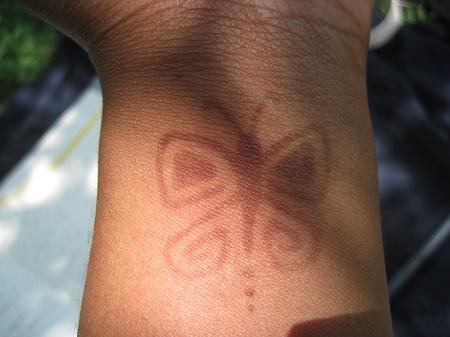Temporary Tattoos may put you at risk, with spring break and summer vacation are around the corner … time to pack your swim suit, hit the beach, and perhaps indulge in a little harmless fun. What about getting a temporary tattoo to mark the occasion? Who could it hurt? It could hurt you.

Left behind from a temporary tattoo
Temporary tattoos typically last from three days to several weeks depending on the product used for coloring and the condition of the skin. Unlike permanent tattoos which are injected into the skin, temporary tattoos marketed as “henna” are applied to the skin’s surface. Henna is a reddish-brown coloring made from a flowering plant that grows in tropical and subtropical regions of Africa and Asia. For centuries, people have used dried henna, ground into a paste, to dye skin, hair, and fingernails. Henna body art—sometimes also known as mehndi—is still used today around the world to decorate the skin in cultural festivals and celebrations.
However, just because a tattoo is temporary it doesn’t mean that it is risk free. Today, so-called “black henna” is often used in place of traditional henna and is potentially harmful. Inks marketed as black henna may actually be hair dye or a mix of henna with other ingredients. The extra ingredient used to blacken henna is often a coal-tar hair dye containing p-phenylenediamine (PPD), an ingredient that can cause dangerous skin reactions in some people. By law, PPD is not permitted in cosmetics intended to be applied to the skin.
You may see “black henna” used in places such as temporary tattoo kiosks at beaches, boardwalks, and other holiday destinations, as well as in some ethnic or specialty shops. While states have jurisdiction over professional practices such as tattooing and cosmetology, that oversight differs from state to state. Some states have laws and regulations for temporary tattooing, while others don’t. So, depending on where you are, it’s possible no one is checking to make sure the artist is following safe practices or even knows what may be harmful to consumers.
A number of consumers have learned the risks the hard way, reporting bad reactions immediately after the application of “black henna” temporary tattoos or even up to two or three weeks later. Reported problems include redness, blisters, raised red weeping lesions, loss of pigmentation, increased sensitivity to sunlight, and even permanent scarring. Some reactions have led to medical treatment, including emergency room visits, and ongoing skin sensitivity that can affect day to day activities.

